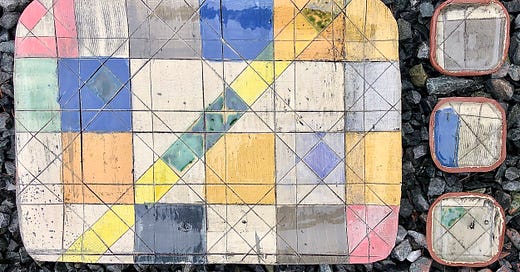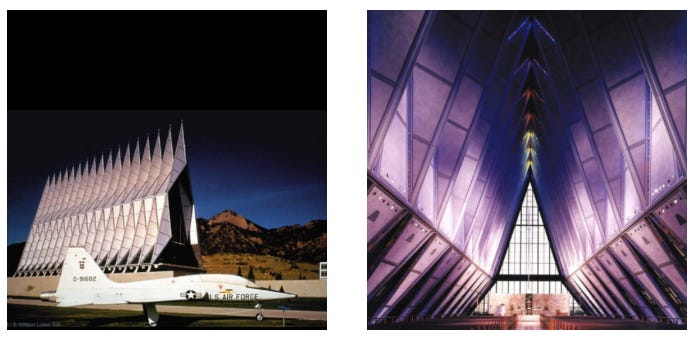Field Theory Platter and Smalls for Saturday’s Chestertown Artwalk
As much as we humans crave complexity & contradiction, we also crave order. There is much in the world today to feel a paralysis of chaos. It is during these times that it’s useful to learn a new approach and learn from past visionaries who can offer us some wisdom. Architect Walter Netsch invented an organizing theory in the chaotic 1960’s that he called “Field Theory”. He was the architect of the stunning chapel at the US Air Force Academy outside Colorado Springs (below). We had the opportunity to tour the prefab chapel before it was dismantled for restoration a few years ago.
In a bit of fun and play in the clay studio, I decided to study Netsch’s Field Theory and how it can help generate new forms in clay. It was also an exploration of some new techniques that could help me in a current art project that’s hatching in the studio regarding Quaker quilts.
Basically, Field Theory is about overlapping grids (generally a rotation of a square) that creates a framework (or field) to lay-out a playful concept. This generates a unique form that is unified throughout multiple layers and intentions. This was decades before AutoCad or Photoshop layers/skins that snap to a grid. And, it draws from educational theory that you may remember with colored Tangrams and geometric polygons. These field grids provide a sort of playground for exploration and invention (where a blank slate or unlimited field leads to arbitrary and random form that lacks cohesion or relevance in design). As with all design theories, Field Theory began in philosophy and scientific observation: Derrida, molecular structures, and Fractals in this case. Here are some of Walter Netsch’s Fields and 1960’s-1980’s buildings he designed using this theory:
Unfortunately, Netsch’s profound contribution to organization theory in architecture was bundled into a popular dislike of anything “Brutalist” in these more-conventional past thirty years (think Martha Stewart/Chip&Joanna). We generally prefer the familiar (safe) to experimental (potential), and we forget that Brutalism is about honesty. Netsch’s complex buildings of kaleidoscopic infinity are generally criticized as postmodern failures to get lost in (forever). He designed a generation of buildings that people love to hate. There is already a movement to preserve and celebrate them for their “Big Try”. I love this period of architecture for its optimism for cities and belief in finding solutions to the human condition. You’ll find a few buildings at Washington College here in Chestertown that embrace this movement of Field Theory to questionable success (image of Fraternity Quad, not designed by Walter Netsch):
You may have recently observed that everything 1960’s-1980’s is suddenly back in vogue in our collective search for order in these disordered times. Why would we want to go back to pink grids or pinstriped geometries?? We suddenly find ourselves looking back to those who came up with communal solutions when everything seemed to be falling apart during the narcissistic “Me Generation”. I suspect it’s a nostalgic revival that matches well with our own cluttered moment in the world that seeks order rather than objective answers. We don’t need to return to the indoor shopping malls, but I encourage you to look back at those creative people who sought a better way to bring beauty and order around us. A grid offers order and something to hang on when things change. We are in a time of change.
So, that’s the thinking behind this new work: an exploration of Walter Netsch’s Field Theory to generate new forms within a sort of geometric algorithm. Hopefully you’ll appreciate some of the thinking behind this experiment to create order with some new techniques. The layers are created with various colored slips and oxides. I encourage you to pick-up one of the examples and look closely when you see them on my table this Saturday at the Artwalk. Like a pine cone, they’re small and contain multitudes I believe.
Thank you for taking the time to read through my design process blog entry. I hope it was interesting for you. Feel free to comment below.









